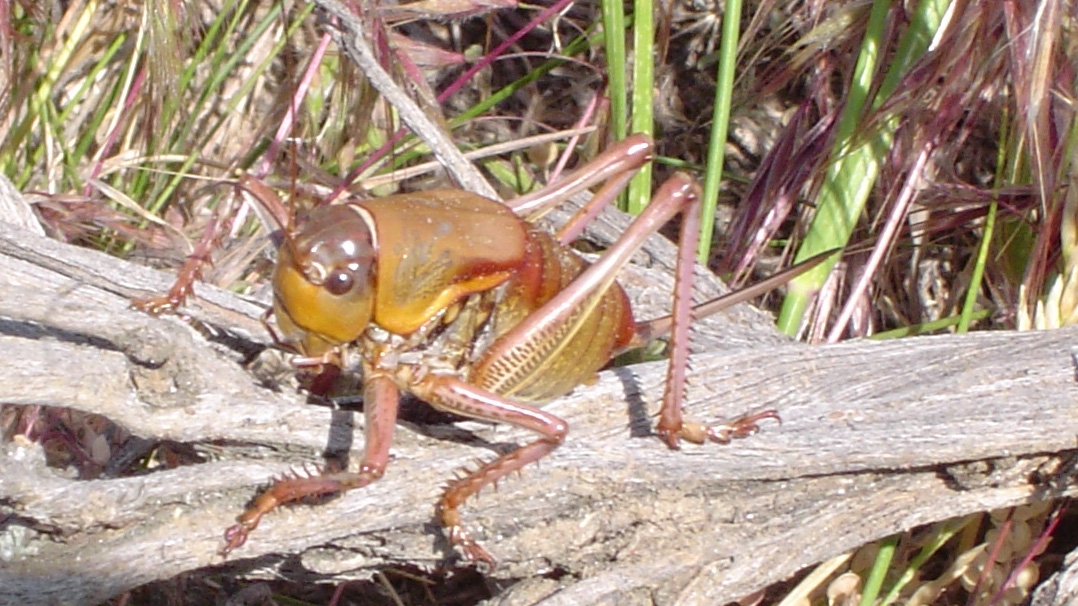Rangeland Grasshopper and Mormon Cricket

Rangeland grasshoppers and Mormon crickets are natural to rangelands (grasslands, shrublands, woodlands, and other plant-heavy areas) in 17 western States. However, when their populations reach outbreak numbers, they can wreak ecological and economic damage, especially when regions are suffering from drought.
These insects eat plant stems and leaves, which interfere with plant growth and seed production. Their appetite can trigger devastating environmental issues, including soil erosion and degradation, nutrient cycle disruption, and water filtration interference. To help landowners treat pest infestations, APHIS oversees the Rangeland Grasshopper and Mormon Cricket Suppression Program.
View Frequently Asked Questions About Grasshoppers and Mormon Crickets in Western States
Larger outbreaks in western States occur every decade or so, but local areas can have larger populations come and go based on environmental conditions and other factors. Here's what to look for:
Rangeland Grasshoppers
These ground-dwelling insects have powerful hind legs that enable them to leap vigorously and escape threats. Most species also have wings that allow them to fly relatively long distances. Sometimes, they're referred to as short-horned grasshoppers to distinguish them from katydids with much longer antennae.
Mormon Crickets
These flightless, shield-backed katydids can migrate great distances. Although they don't fly, Mormon crickets walk or jump in large groups made up of millions or billions of individual insects. The Mormon cricket is the only katydid species known to hatch outbreak populations in the United States.
Are you a landowner or land manager dealing with a rangeland grasshopper and Mormon cricket infestation? We provide technical assistance, deliver public outreach programs, and help suppress populations when direct intervention is needed.
To request assistance, send an email or letter to your State plant health director. Upon receipt, we'll assess several factors on your land:
- Rangeland grasshopper and Mormon cricket densities per square yard
- Pest species (Nearly 400 grasshopper species inhabit western States, but only 12 species are considered pests.)
- Pest life stage
- Treatment timing and options
These factors, and other ecological considerations, will determine if treatment will be effective on your land. Pending availability of funds, APHIS will pay for all or some of the treatment on Federal, State, and private lands.
The preferred treatment option is the Reduced Agent and Area Treatments (RAATs) method, which treats less land area overall and uses insecticides at lower rates and volumes. RAATs alternate between treating and skipping swaths of rangeland. Skipped swaths often total 50 percent or more of a given area. In this scenario, the insecticide suppresses pest populations in the treated swaths while conserving their predators and parasites, as well as other non-target insects, in the skipped swaths.
We have the option to use four insecticides: carbaryl, diflubenzuron, malathion, and chlorantraniliprole. A suppression treatment consists of one treatment a year of one of these insecticides. Each insecticide is registered for use and labeled by the U.S. Environmental Protection Agency (EPA) for sufficient management of rangeland grasshoppers. The insecticide APHIS chooses depends on several factors, including outbreak density, species, population age, climate, weather, land conditions, economics, and environmental risks.
When properly applied, each insecticide is very effective and safe for people, animals, and the environment. We conduct and post public environmental assessments in each State before taking any actions. We follow all insecticide label directions, along with conditions outlined in the environmental impact statement, the environmental assessments, program guidelines, and the treatment request letter.
Report Plant Pests and Diseases
Have you seen this pest or signs of pest damage? Immediately report your findings.
Find your State plant regulatory official
Find your State plant health director
Controlling Grasshoppers and Mormon Crickets
- Grasshopper Hazard Map (683.58 KB)
- ID Tool: Grasshoppers of the Western United States
- Factsheet: Protecting U.S. Rangeland From Grasshoppers and Mormon Crickets (762.68 KB)
- Mobile App: Grasshoppers of the Western United States
- Download for iOS
- Download for Google Play
The following site-specific environmental assessments for the rangeland grasshopper and Mormon cricket suppression program are open for comment.
| Document Number | State | Comments Due | Send Comments To | Questions and Comments |
|---|---|---|---|---|

